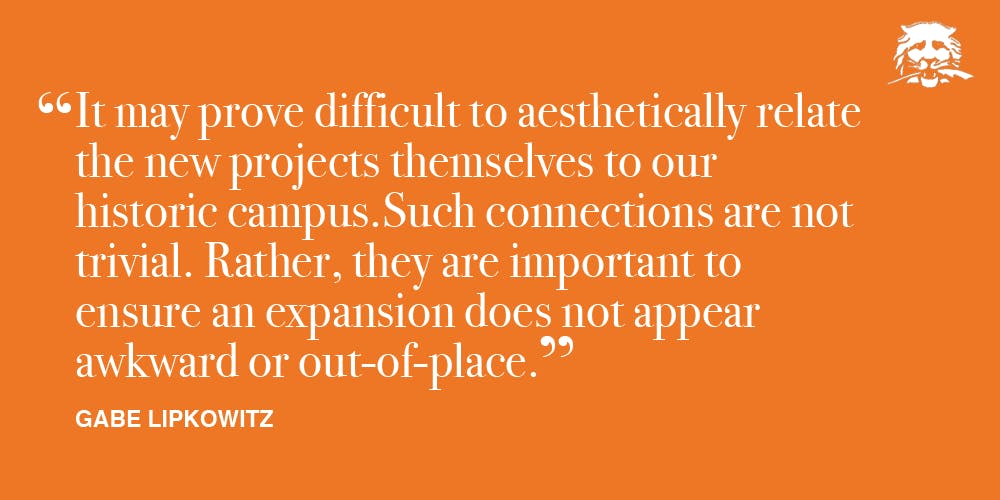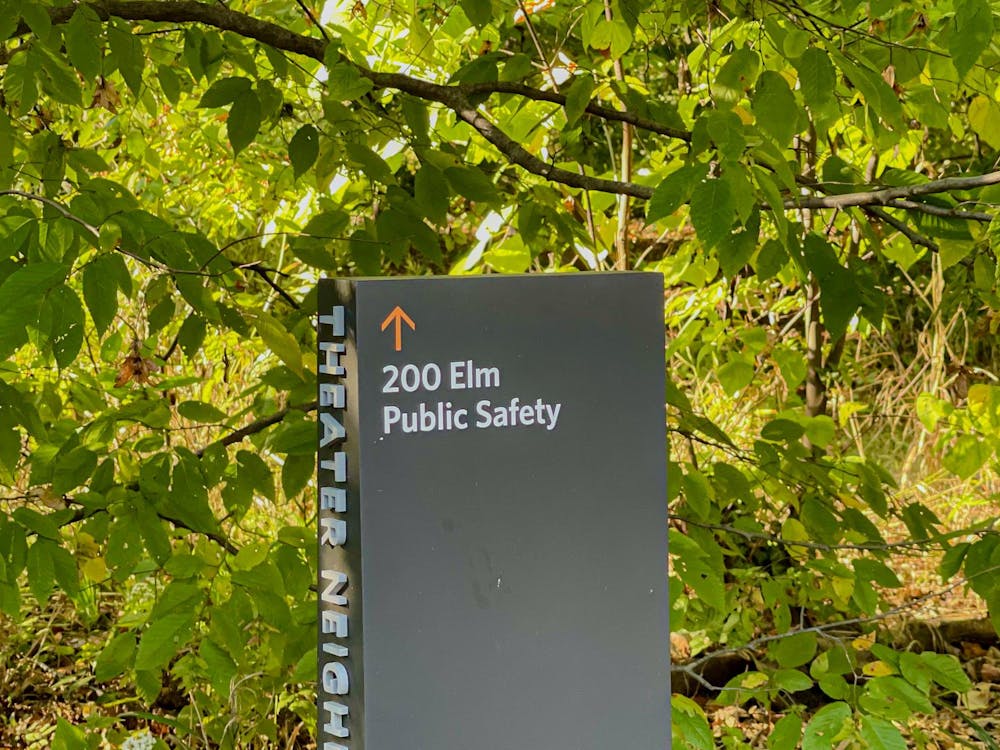“We may live without [Architecture] and worship without her, but we cannot remember without her.” -- John Ruskin, The Seven Lamps of Architecture
When they exit FitzRandolph Gate tomorrow, graduating seniors may wonder how they’ll remember their University experiences in the years to come. A powerful stimulus for these memories, especially during a return to campus, is architecture.
Gazing at the grand neoclassical style of Robertson Hall, a Woody Woo major might remember debating American politics and democracy in that building.
Peering through one of the many small windows of Lewis Thomas Laboratory, a molecular biology major may think back to late nights spent in the lab doing research.
Revisiting the quiet basements of Fine and Jadwin Halls, a physics major may recall solving difficult problem sets with fellow students.
While memories may fade over the years, these campus spaces will remain as wonderful reminders for every soon-to-be University graduate of their time here.
But what about parts of our campus that will not be familiar when they return?

In December of last year, the University released an ambitious Campus Plan for 2026. It called for new residential colleges south of Poe and Pardee fields, engineering and environmental science complexes east of Washington Road, and perhaps most radically, development south of Lake Carnegie. This so-called “Lake Campus” will contain athletics facilities, administrative and innovation spaces, and graduate student housing.
This expansion holds great promise. It will hopefully allow the University to undertake new research initiatives, expand its faculty, and further diversify the student body.
Still, the unprecedented scale of this expansion means it has the potential to transform the character of our campus. Accordingly, it demands the attention of students and alumni alike.
Personally, I worry that these new projects will struggle to integrate with our historic campus, both spatially and aesthetically.

For one, these projects’ accessibility may prove problematic. Since few non-athletes venture beyond Poe Field today, the new residential colleges located south of it may struggle to attract student traffic. While the colleges themselves will inevitably compel the students living there to make the journey, a lack of other activities and classes in the area will diminish the incentive for others to do so. This raises the possibility that the new colleges will be even more geographically isolated than Forbes College, whose distance from central campus already makes it an island of sorts.
Neither can Poe Field itself promote transit to these new areas. While this expansive green is appealing on a sunny day, it forces students to take a long and circuitous path to cross what seems to be a short distance. Accordingly, it presents a veritable barrier to integration of new residential colleges with the center of campus.
Access to the proposed Lake Campus will be even more problematic. Right now, the bridge on Washington Road crossing Lake Carnegie would provide one link, but this is hardly conducive to pedestrian traffic. Traversing this bridge with automobiles zooming alongside utterly contradicts the pedestrian experience central to the University’s campus. While the University is in the process of planning a new pedestrian bridge, it is difficult to see how one such project could overcome the formidable physical and psychological barriers to integration a lake presents.
One might argue that the University has undertaken projects at the periphery of our campus in the past, and students have found ways of accessing them. However, these were far less spatially distant than the current plans. The Lewis Arts Center, finished last year, was already perfectly situated between well-trafficked student destinations like Forbes, the Wa, and New South Building. Likewise, the Frick Chemistry Laboratory completed in 2010 was positioned on a well-traversed path between Streicker Bridge and Princeton stadium.
The projects outlined in the Campus Plan, especially the Lake Campus, do not benefit from such ideal positioning. The University architect Ron McCoy GS ’80 insists that encouraging students to use bicycles for transportation will solve the issue. While certainly preferable to automobiles, this would still disrupt the pedestrian campus experience. Already, some University walkways — notably Goheen Walk — sometimes seem more like bicycle highways than casual pedestrian avenues. Importantly, it is far more difficult to converse with fellow students while biking than walking. Even if cycling solves issues of access to new projects, therefore, we should still worry about how this will transform the student experience.
Adding to these issues, it may prove difficult to aesthetically relate the new projects themselves to our historic campus.
Such connections are not trivial. Rather, they are important to ensure an expansion does not appear awkward or out-of-place, and instead embraces what McCoy calls our campus’s “distinctive sense of place.”
This has not been a problem for other recent University projects closer to the center of campus, where architects could cleverly build off of the history of their pre-existing sites. The award-winning renovation to the new economics building, for instance, juxtaposed a historic collegiate neo-Gothic façade with a contemporary interior space to create a remarkable architectural synergy. Similarly, the fluid design of the Lewis Arts Complex built off the historic transit route it replaced, which had long served as the railroad track for the Dinky.
The only history to which designers of the new southern residential colleges can respond, by contrast, comes from athletic facilities built less than a decade ago. Even more glaringly, the preexisting “site” for much of the Lake Campus will be largely untamed forest.
Offered such a tabula rasa, architects selected for these new projects may be tempted to adopt radical designs that prioritize novelty over relationships to the historic campus. The physical distance separating them from the center of campus may justify a sort of declaration of independence, in an architectural sense.
This is a scary thought. If such an approach is implemented, students, alumni, and visitors will be left confused as to the identity and unity of our otherwise beautiful campus. My worst nightmare is something akin to the haphazard mishmash of architectural styles that characterizes poorly thought-out suburban sprawl.
It is important not to be too pessimistic. Indeed, designers often cite how challenges and limitations can breed creative solutions.
If the University can connect the new and old campuses with innovative and effective pedestrian pathways, then it will alleviate the potential issue of inaccessibility. Likewise, if its new designs can successfully relate to historic structures in clear and explicit ways, then they will evolve with time to become extensions of our campus, rather than merely additions to it.
To ensure this positive outcome, we as students and alumni must provide input throughout this process — and the University architects must take it into account. Community engagement, whether in person or online, is essential during this period of remarkable growth. Nothing less than the future identity of our campus is at stake.
Gabriel Lipkowitz is a junior in molecular biology from Charlottesville, Va. He can be reached at gel@princeton.edu.








